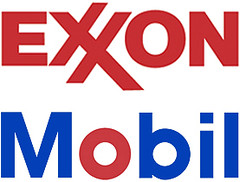Exxon sets record with $40 billion US annual profit
 Exxon Mobil Corp. posted the largest annual profit by a U.S. company Friday — $40.6 billion US — as the world's biggest publicly traded oil company benefited from record-high crude prices at year's end.
Exxon Mobil Corp. posted the largest annual profit by a U.S. company Friday — $40.6 billion US — as the world's biggest publicly traded oil company benefited from record-high crude prices at year's end.
Exxon also set a United States record for the biggest quarterly profit, posting net income of $11.7 billion for the final three months of 2007, beating its own mark of $10.7 billion in the fourth quarter of 2005.
The previous record for annual profit was $39.5 billion, which Exxon Mobil made in 2006.
The eye-popping results weren't a surprise given record prices for a barrel of oil at the end of 2007. For much of the fourth quarter, oil hovered around $90 US a barrel, more than 50 per cent higher than a year ago.
Crude prices reached an all-time trading high of $100.09 on Jan. 3 but have fallen about 10 per cent since.
Exxon Mobil, which owns 70 per cent of Canada's largest oil producer and gasoline refiner and seller, Imperial Oil Ltd., is one of the world's biggest energy companies, with three per cent of global oil output.
The record profit for the October-December period amounted to $2.13 a share versus $1.76 a share in 2006. Year-ago net income was $10.25 billion.
Also extraordinary was Exxon Mobil's revenue, which rose 30 per cent in the fourth quarter to $116.6 billion from $90 billion a year ago.
For the year, sales rose to $404.5 billion — the most ever for the Irving, Tex.-based company — from the $377.64 billion it posted in 2006.
In a statement, Exxon Mobil chairman Rex Tillerson said the company continued to meet the world's energy needs through its "globally diverse resource base."
"Our long-term investment program, in projects often far from major consuming nations, continued to provide resources essential to the increasingly interdependent global energy supply network," Tillerson said.
Imperial posts record-high profits
Exxon Mobil's results came a day after Calgary-based Imperial reported record high profits last year on higher crude prices, smooth-running marketing and refinery operations and higher volumes from the Syncrude oilsands project in northern Alberta.
The positive factors for the year were offset a bit by lower than expected conventional resource volumes, pressure from the rising Canadian dollar and higher tax expenses.
The Canadian company earned $3.19 billion Cdn in 2007 on revenue of $25 billion, beating Imperial's previous record of $3.04 billion set in 2006 on revenue of $24.5 billion. In the fourth quarter, Imperial Oil earned $886 million, up from $794 million. Fourth-quarter revenue increased to $6.7 billion from $5.5 billion a year ago.
In trading on the New York Stock Exchange on Friday, Exxon Mobil shares fell 45 cents to $85.95 US after rising as high as $87.86 earlier in the session. The shares have traded in a 52-week range of $69.02 to $95.27.
Higher commodity prices in the quarter were clearly evident from earnings at Exxon Mobil's exploration and production arm, known as the upstream. Income rose 32 per cent to $8.2 billion from $6.2 billion a year ago.
On an oil-equivalent basis, production increased nearly one per cent from the fourth quarter of 2006. Excluding the expropriation of its Venezuelan assets last year, divestments and other factors, production rose nearly three per cent.
Refining and marketing, or downstream, earnings were $2.3 billion, up from nearly $2 billion in the year-ago quarter, as improved refining operations offset lower U.S. refining margins.
In the U.S., downstream earnings were off sharply from a year ago — $622 million in the most recent quarter versus $945 million in 2006.
Refining margins — the difference between the cost of crude and what the company makes on refined products such as gasoline — have been squeezed in recent months as spiking oil prices outpaced increases in gasoline prices and other refined products.























